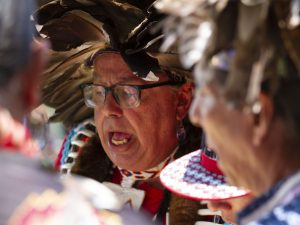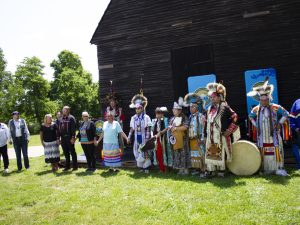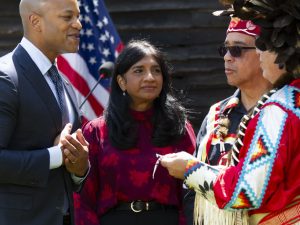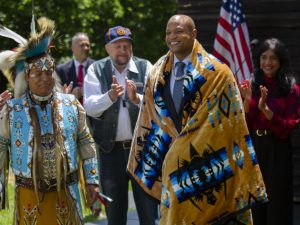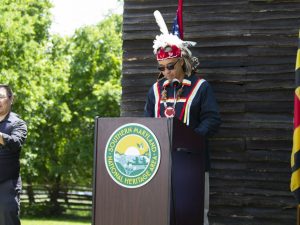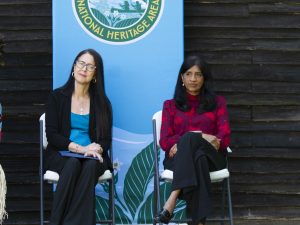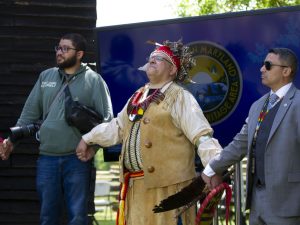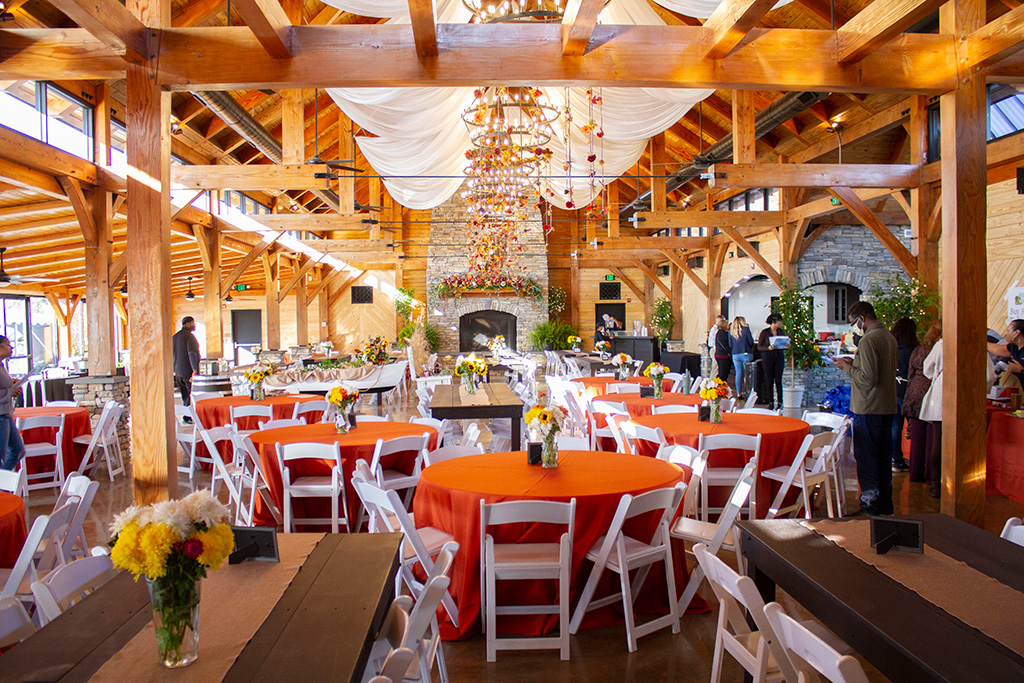New designation will bring federal, state, and private resources to promote heritage tourism, conserve natural landscapes, and enhance the local economy.
(ACCOKEEK, Md. – Today, May 25, 2023) Destination Southern Maryland celebrated the recent National Heritage Area designation for Calvert, Charles, St. Mary’s, and southern Prince George’s counties that will raise the national and international profile of the region and bring significant economic benefits. Maryland Governor Wes Moore served as keynote speaker at the event, which was attended by hundreds of Maryland residents.
The southern Maryland national heritage area
“Maryland now has a new National Heritage Area to highlight the profound national and international significance of the state, and federal funding to assist with that mission, thanks to our federal partners,” said Moore. “This designation raises the profile of the region and brings great economic, environmental, and cultural benefits. National Heritage Areas connect communities, promote awareness, and foster interest in our rich natural resources and diverse heritage. In Maryland, we are a land of First People, with the Piscataway sharing their legacy with us here today. It was in the first capital of Maryland, St. Mary’s City, where the basic human right of religious freedom was put into law for the first time in the entire Western world. Today is a celebration of our state’s heritage where it all began, in southern Maryland.”

Additional speakers included U.S. Department of the Interior Assistant Secretary for Fish and Wildlife and Parks Shannon Estenoz, Maryland Lieutenant Governor Aruna Miller, Chief Mark Tayac of the Piscataway Indian Nation, Chairman Francis Gray of the Piscataway Conoy Tribe, and Southern Maryland National Heritage Area Executive Director Lucille Walker.
“The Southern Maryland National Heritage Area, like all the 62 national heritage areas in the country, is a vibrant, lived-in landscape, that celebrates the area’s unique history, culture and nature,” said Assistant Secretary Shannon Estenoz. “The Department of the Interior and National Park Service look forward to a robust collaboration with our partners to conserve and promote the exceptional opportunities for recreation, tourism, and conservation in southern Maryland.”
National Heritage Areas are places where historic, cultural, and natural resources combine to form cohesive, nationally important landscapes. Congress passed the Southern Maryland National Heritage Area Act (included in the Heritage Areas Act) on Dec. 22, 2022, and it was signed into law by President Joe Biden on Jan. 5, 2023. The bipartisan legislation, sponsored by Sen. Ben Cardin (D-MD), Sen. Chris Van Hollen (D-MD), and Rep. Steny Hoyer (D-MD), authorizes $10 million in federal funding over 10 years.
“The Southern Maryland National Heritage Area will commemorate and promote the unique historic, cultural, and natural resources in St. Mary’s, Calvert, Charles and Prince George’s counties,” said Cardin. “I am proud to have partnered with my colleagues Steny Hoyer and Chris Van Hollen, as well as a coalition of local partners led by Destination Southern Maryland, to make this new national heritage area a reality. Federal recognition of this extraordinary region is a great win for Maryland.”
This designation will increase educational and historical programs in the region, which will lead to more tourism and overall economic growth. National Heritage Areas leverage federal funds at an average of $5.50 in economic activity for every $1.00 of federal investment to create jobs, generate revenue for local governments, and sustain local communities through revitalization and heritage tourism.
“Southern Maryland has a vast array of natural and historical treasures,” said Van Hollen. “With this official designation as a National Heritage Area and the additional federal resources we plan to access, we can better tell the full story of southern Maryland—its culture, unique places, and role in American history—to local residents and visitors alike. I was glad to join Senator Cardin and Congressman Hoyer in the fight to make this vision a reality, and I’m excited about all of the economic benefits it will bring to southern Maryland and its small businesses in the coming years.”
National Heritage Areas also connect communities to natural, historic, and cultural sites through educational activities that promote awareness and foster interest in and stewardship of heritage resources.
“Last Congress, I was pleased to introduce and help pass legislation in the House to designate southern Maryland as a National Heritage Area,” said Hoyer. “From Piscataway Native Americans and their vibrant society to early colonists who sought religious freedom to brave abolitionists who helped enslaved people escape to freedom, many trailblazers have walked the shores of the Chesapeake Bay and the banks of its tributaries. Our southern Maryland communities have long maintained a deep connection to this heritage and to the surrounding environment. We have a duty to preserve this region’s history, conserve its ecosystem, and support its economy, and this legislation devotes federal resources to that effort. I thank my friend Senator Ben Cardin and the rest of the Maryland Congressional Delegation for their support on this bill.”

As part of a National Heritage Area, Maryland’s waters and landscape will benefit from additional restoration projects, supporting the ecosystems and the communities that rely on them.
The event included cultural and artistic performances, including the Piscataway Indian Nation drums, Spring Ridge Rhythm Club, and colonial singers David and Ginger Hildebrand. It also featured a visit from the Maryland Dove, a re-created 17th century historic ship, which sailed in from St. Mary’s County.
Southern Maryland is home to First People, a vital component of the heritage and history of the region, Maryland, and the nation.
“We are at the principal capital village, where we stand today, of the Village of Moyaone,” said Chief Mark Tayac of the Piscataway Indian Nation. “This is the historical seat of government occupied by the Piscataway for 15,000 years. When we touch the soil here, we are touching the generation of those before us. Who we were and who we are today as Piscataway is intermingled with this land. The 27th generation of hereditary chiefs, Chief Turkey Tayac, is buried within the borders of the Village of Moyaone, which is now known as Piscataway National Park. This was the first time that an American Indian was buried on a federal park after its creation. This took an Act of Congress. This was and is a proud moment in the history of the state of Maryland. As we embrace Maryland’s heritage, we recognize that the Indian people of this land are still here today.”

“The Piscataway Conoy, Maryland’s indigenous people, are excited to have the opportunity to invert the narrative of Maryland’s colonial story and to tell our story through the eyes of the Piscataway—to speak of our past, purpose, and the resilience of a people who have had to continuously overcome challenges throughout many years, resulting in changes that dramatically affected the way of life of our people, “ said Chairman Francis Gray of the Piscataway Conoy Tribe. “The designation of the Southern Maryland National Heritage Area is a positive step and will pull into motion an extremely important and long overdue effort to record, document, protect, and raise awareness about our history from a cultural perspective that will convey the proud heritage of our Piscataway people.”
In addition to the region being the birthplace of religious freedom—the beginning of the separation of church and state—the region is home to many other “firsts”: the first time a person of African descent ever served in a legislature in America (Mathias de Sousa, 1641); the first time a woman ever petitioned for the right to vote (Margaret Brent, 1648), the first national marine sanctuary on a river (Mallows Bay–Potomac River National Marine Sanctuary), and many more.
“This unique and exciting designation bridges communities, builds partnerships, and shares stories of resilience that span thousands of years,” said Southern Maryland National Heritage Area Executive Director Lucille Walker. “The fact that we received the designation in just two years is a testament to the power of partnerships—federal, state, and local legislators worked across the aisle to shine a national light on the region’s stories and history and enhance funding so we can enjoy all that the area has to offer for generations. By preserving and sharing our deep-rooted and diverse history, Maryland can celebrate its heritage while creating a better future for all.”

With the new Southern Maryland National Heritage Area, there are now two Maryland-centered National Heritage Areas; the other is the Baltimore National Heritage Area. There are also two multistate heritage areas that include Maryland: the Appalachian Forest National Heritage Area (parts of Maryland and West Virginia) and the Journey Through Hallowed Ground National Heritage Area (parts of Maryland, Pennsylvania, Virginia, and West Virginia).
learn more: https://destinationsouthernmaryland.com/press/
For more exclusives and video interviews please visit our Facebook page @waldorflive and Youtube.







